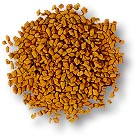|
 
|
The web site........,
exploring
the pure
Indian spices
and....
imperishable
dry vegetables
of
THAR....the great desert
.
|
| |
| |
|

Fenugreek has a strong, pleasant and peculiar odour reminiscent of maple.
Itís a warming spice. The ancient Egyptians used it as food and as an
embalming agent. The Romans used it as cattle feed. |

|
In India, fenugreek is a cover crop. Major producers are Rajasthan, Gujarat,
Uttar Pradesh & Tamil Nadu. |
| Botanical name |
Family name |
Commercial part |
| Trigonella
foenum-graecum L. |
Fabaceae |
Fruit |
|
Cultural
name |
English
name |
Botanical
name |
Moisture
g/100g |
Protein
g/100g |
Fat
g/100g |
Minerals |
Fiber
(g) |
Carbohydr
ate
g/100g |
Energy
Keal/1000g |
|
Mathi |
Fenugreek
seed
|
Trigonella
foenumgraecum |
13.7 |
26.2 |
5.8 |
3.0 |
7.2 |
44.1 |
333 |
| |
|
|
Calcium
mg/100g |
Iron
mg/100g |
Phosphorus
mg/100g |
| |
|
|
160 |
6.5 |
370 |
|

A favourite Indian dish is 'methi aloo'
or potatoes made quite dry in a frying pan, flavoured with fenugreek. It is
found more often in Indian pickles than curries. Fenugreek leaves are used
only in Indian cooking. Fenugreek stimulates blood and hair development, as
well as weight loss. It is also used as a female rejuvenative, because of
its rich concentration of B vitamin, folic acid.
|
Name in International
languages
| Spanish |
Alholva |
| French |
Fenugrec |
| German |
Bockshorklee |
| Swedish |
Bockshornklee |
| Arabic |
Hulba |
| Dutch |
Fenegriek |
| Italian |
Fieno Greco |
| Portuguese |
Alforva |
| Russian |
Pazhitnik |
| Japanese |
Koroha |
| Chinese |
K'u - Tou |
| Hindi |
Methi |
|
|